TMJ – TMD Disorders
TMJ Disorder is a condition that can cause pain and dysfunction in the jaw joint and muscles that control jaw movement. The National Institute of Dental and Craniofacial Research estimates that TMJ disorders affect over 10 million Americans. The condition appears to be more common in women than men.
Temporomandibular Joint (TMJ) is an orthopedic joint, like any other joint in your body. The TMJ connects the mandible (lower jawbone) to the temporal bone of the skull in the front of the ear. The disc cushions the load while enabling the jaw to open widely and rotate or glide. Any problem that prevents this complex system of muscles, ligaments, discs and bones from working properly may result in a painful TMJ disorder.
Temporomandibular Dysfunction (TMD) includes the jaw joint (TMJ), muscles, tendons, ligaments, and nerves.
Normal TMJ Movement
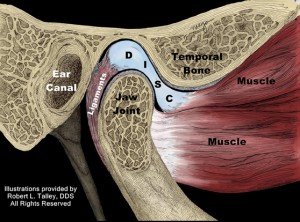
Image 1: Normal TMJ (Teeth are Together)
In IMAGE 1, the disc is between the condyle (jaw joint) and the temporal bone. It provides cushion and allows the condyle to glide along the temporal bone. Without this cushion, the two bones will wear each other down causing degeneration of the bones and pain.
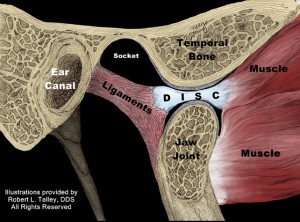
Image 2: Normal TMJ (Mouth Open)
In IMAGE 2, the jaw opens the disc and stays between the condyle and temporal bone.
What causes Clicking or Popping of the Jaw Joint?
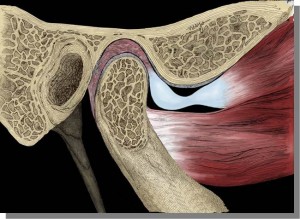
Image 3: Disc is Displaced
In IMAGE 3, when a jaw joint “clicks” or “pops” when opening and/or closing it is an indication of a TMJ disorder. When the upper and lower teeth are together, the disc is off the jaw joint (condyle). This may cause ringing, stuffiness or fullness of the ears, earaches, temple pain, and/or facial pain. TMJ pain can also occur but many times pain is not experienced.
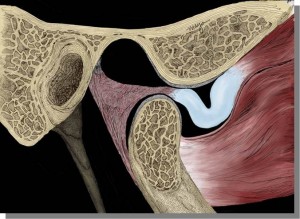
Image 4: Disc is Displaced
In IMAGE 4, as the jaw opens, the disc starts to fold on itself and the ligaments begin to stretch.

Image 5: Normal open Diagnosis: Disc Displacement with Reduction
In IMAGE 5, as the jaw opens wider, the ligament stretches to its limit and the disc slips onto the jaw joint. An audible “click” or “pop” can be heard or felt. The disc is now back on the jaw joint. As the jaw closes, the disc slips off the jaw joint (Image 3). Sometimes an audible “click” or “pop” can be heard or felt, although many times it is silent.
As this condition becomes more chronic, the “click” or “pop” becomes less audible. As a result, many people tend to think their TMJ condition is getting better, but in fact it is becoming worse. Clicking or popping of the jaw joint can last as little as a week to many years before the disorder may move on to the next stage of the jaw locking closed.
What is Lockjaw vs. Closed Lock?

Image 6: Disc out of place
Lockjaw (Trismus) is the inability of the jaw to open due to spasm of the jaw muscles. Trismus can occur from facial trauma (a blow to the face), muscle injury (dental injection or sustained opening of the mouth for dental care) or infection of the muscle (dental injection or an abscessed tooth). Trismus can be resolved in most cases, especially if treated early.
Closed Lock is the termed used for a TMJ disorder in which the disc is off the jaw joint and the disc does not slip back onto the jaw joint when opening ones mouth. Opening of the mouth can occur but it is limited, usually limited to half of its normal opening.
In IMAGE 6, the upper & lower teeth are together and the disc is off the jaw joint (condyle). This may cause ringing, stuffiness or fullness of the ears, earaches, temple pain and/or facial pain. TMJ pain is experienced by many people when a TMJ disorder advances to this stage.
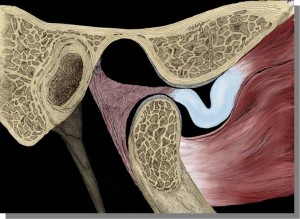
Image 7: Diagnosis: Disc Displacement without Reduction
In IMAGE 7, as the jaw is opened, the disc does not slip onto the jaw joint. As a result, the disc limits the jaw joint from advancing forward which prevents the jaw from fully opening. This is what causes limited opening as well as pain.
The disc can be reduced (placed back onto the jaw joint) by a painless joint injection, especially if treated early after onset.
If treatment is not done, degeneration of the TMJ may occur causing more pain and dental problems.
Advanced stage of a TMJ Disorder
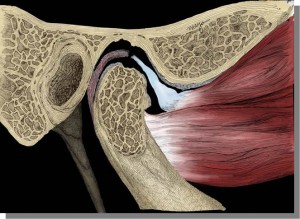
Image 8: Degenerative TMJ Disease
In IMAGE 8, TMJ disorders can progress to degeneration of the joint and surrounding tissues. Bone, ligaments and disc deterioration can occur if TMJ disorders are left untreated.
Dr. Busciglio has treated many patients with TMJ disorders. Many patients with a TMJ disorder usually have a muscle disorder causing headaches, migraines, neck and/or shoulder pain, ear pain, tinnitus, and many other symptoms.
In most cases, Dr. Busciglio can significantly reduce or eliminate your pain in two to four weeks after therapy is initiated. You do not need to suffer from TMJ or TMD symptoms any longer. Call Bay Area TMJ and Sleep Center today to schedule a comprehensive evaluation.
*Illustrations provided by Robert L. Talley, DDS; All Rights Reserved
